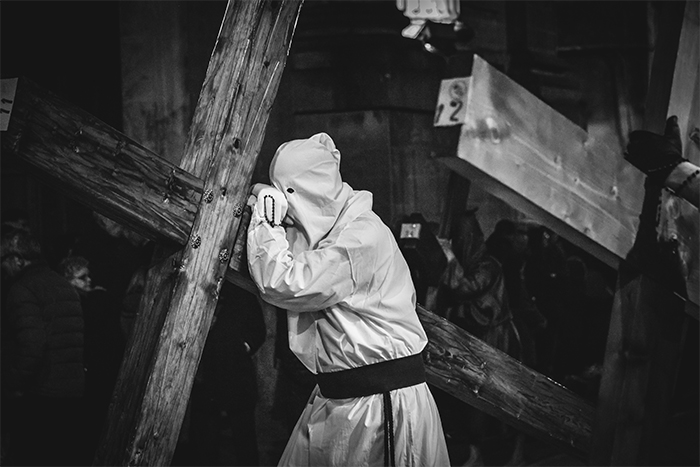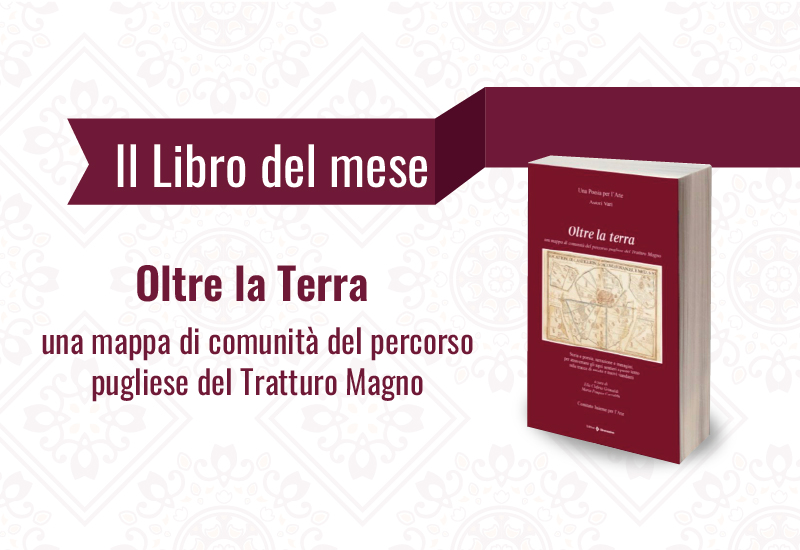FROM THE NAVEL OF THE WORLD TO FINIBUS TERRAE
A strait between two seas: an ancient land immersed in rapid change, a bridge to the east and the cradle of renewed interest in ancient rites that the local people have been able to revive.
A land of baroque, in the ancient limestone nuclei, which lights up with golden hues in the sweetest hours of the day. The pilgrimage of the 'pappamusci' of FRANCAVILLA FONTANA, Good Friday in GALATINA, land of the 'tarantate', the encounter between the Madonna and the dead Christ on the wall of GALLIPOLI have as their backdrop 'I Canti di Passione' (Passion Songs) of GRECIA SALENTINA in the Griko language of Salento and the female procession of BOTRUGNO.
A strip of land lying between two seas, like an exhausted young woman sleeping cradled by the waves; an ancient land yet alive with changes that do not affect its character and passion.
This is Salento, the heel of Italy and bridge to the east, cradle of ancient rites that many are only now discovering thanks to tourism development. If you want to get to know the most authentic Salento, then the Easter period is certainly the most suitable.
With the façades of the churches steeped in Baroque and the shining limestone that glows gold in the hours of sunset, FRANCAVILLA FONTANA is the place of pilgrimage of the 'pappamusci', penitents in white coats and hooded, barefoot, who with a stick in their hands on Holy Thursday visit all the churches of Francavilla praying on their knees before the Repository known as the 'Sepulchre'.
The rite is handed down by the Carmelite friars who, in the Holy Land, accompanied pilgrims to visit the sites of Christ's Passion.
Here, amidst evocative palaces and loggias, you can breathe in the scent of 'curly' sugared almonds made from toasted almonds and the tasty poor man's cake 'la copeta'.
The most intense and participatory days are concentrated from Holy Wednesday to Good Friday: Wednesday with the dishes carried around by children who for centuries have been repeating "CCe ti piace lu piattu mia?", Thursday with the ancient pilgrimage of the Pappamusci, and Friday with the moving procession of the Mysteries followed by the 'Pappamusci cu li trai', who drag heavy crosses as a sign of devotion.
On Good Friday, the pilgrimage continues: first with the procession of the 'Desolata' in a surreal silence interrupted only by the typical sound of the 'tremule', small boards on which handles are mounted and which, with a flick of the wrist, emit a high-pitched sound; then continuing with the procession of the Mysteries of Christ closed by a group of crucifiers known as 'li pappamusci cu li trai' dragging heavy crosses prepared by them with wooden logs of various thickness and size.
Follow their emotional journey as you admire the beauty of the city while savouring the typical flavours and scents of an early spring night.
We then move further south, entering the heart of Salento. Passing through GALATINA, the city of 'tarantate' and 'pizzica', we arrive on the Ionian coast at 'Kale Polis' (from the Greek for 'beautiful city'): GALLIPOLI with its castle embracing the 'Padella': this is how the historical centre of Gallipoli is called, since in aerial views the circular old town and the bridge - which looks like a handle - give the idea of a frying pan.
The narrow stone streets of Lecce welcome Good Friday, but it is the crystal-clear green of the sea and the lush pine forests sloping gently down to the coast that provide the backdrop for the Procession of Mary Desolate, organised by the confraternity of S. Maria della Purità.
The hooded men, wearing a white habit and hood, straw-yellow mozzetta and red cingulum, precede the statues of the Dead Christ and Mary Desolate, who meet in a powerful moment of emotion on the wall of the old city on Holy Saturday.
We leave the beautiful city and enter the territory of GRECÌA SALENTINA, a land suspended in time where the Griko language is spoken, a neo-Greek dialect that encapsulates all the hospitality of a people who have strongly desired to keep their identity and their artistic and cultural heritage intact.
Here, where every year the Festival of the Notte della Taranta is held, an event that is now an international event, Holy Week could not fail to be characterised by the typical musicality of the Canti di Passione.
These are devotional songs of the Passion of Christ that take place inside and in the churchyards of the most beautiful churches in the 'griki' municipalities (Calimera, Carpignano Salentino, Castrignano dei Greci, Corigliano, Cutrofiano, Martano, Martignano, Melpignano, Soleto, Sternatia and Zollino). In these songs, sometimes interpreted by the elders of the communities, popular poetry has reached one of its highest expressions in the events that narrate the life and death of Christ and constitute a priceless intangible heritage.
Continuing the descent into the mysterious land of Salento, towards the point of 'finibus terrae' with the sanctuary of Santa Maria di Leuca and the great lighthouse located on the promontory from which the gaze is lost in the open spaces of the Mediterranean, we then reach BOTRUGNO. The small municipality of about 3,000 inhabitants in the province of Lecce, boasts Greek origins but it is with the various local noble families that its economy flourished, based mainly on agriculture and livestock breeding.
Among the typical products you can find full-bodied local wines and the unique Salento oil that will give you a taste experience you have never had before.
Francavilla Fontana, the Easter processional rites of the Pappamusci cu li trai on Good Friday
Tourists in the Grecìa Salentina
Martignano, Passion Songs during Holy Week
Francavilla Fontana, Good Friday procession of the Pappamusci
Soleto, the beautiful church of Santo Stefano
Salento Greece, the tradition of the Cammarate blown up on Easter Day
Galatina. the splendid frescoes inside the Basilica Santa Caterina d'Alessandria
Martignano, Passion Songs during Holy Week
Gallipoli, Good Friday procession with the meeting of the Dead Christ and the Madonna
Martignano (Greek Salento), tourist service centre
Francavilla Fontana, the interior of the Castello degli Imperiali
Francavilla Fontana, Palm Sunday
Gallipoli, Good Friday procession in the historic centre
Francavilla Fontana, the imposing basilica of the Most Holy Rosary
Francavilla Fontana, the Good Friday Pappamusci
Galatina, the beautiful basilica of St Catherine of Alexandria
Francavilla Fontana, the Good Friday Procession of the Mysteries
Francavilla Fontana, the symbols of the Easter rites of Holy Week
Gallipoli, Good Friday procession in the narrow streets of the historic centre
Gallipoli, Good Friday Procession of the Mysteries
Holy Week in Apulia
Gallipoli, processional rites in the alleyways of the historic centre
Botrugno, the all-female Good Friday procession
Francavilla Fontana, typical Easter sweets
Galatina, the tasty pasticciotti
Grecìa Salentina, the tasty grika sandwich
Mesagne, the excellent wines of Cantine Pandora, visit. our online shop
Buy products from Pugliautentica, visit our online shop




